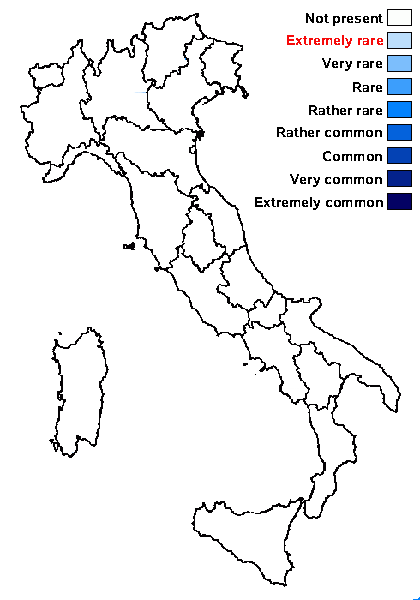Thelidium decussatum (Kremp.) Zschacke
Hedwigia, 62: 126, 1920. Basionym: Arthopyrenia decussata Kremp. - in Rabenhorst, Flecht. Europ., 33: no. 646, 1862.
Synonyms:
Distribution:
Description: Thallus crustose, thinly episubstratic, continuous to partially rimose, dull dirty grey, surrounded and crossed by black lines. Perithecia black, hemispherically projecting, with a flattened ostiolar region, 0.3-0.4 mm across. Involucrellum thick, black, dimidiate; exciple globose, 0.2-0.25 mm across, the wall black throughout; hamathecium of periphyses and periphysoids, interascal filaments absent; hymenial gel I+ red (I+ blue at very low concentrations of I), K/I+ blue. Asci 8-spored, ellipsoid to clavate, I-, fissitunicate, the wall thickened above, with an ocular chamber, dehiscent by extrusion of a delicate rostrum, 65-70 x 30-35 µm. Ascospores 1-septate, hyaline, ellipsoid, 21-27 x 8-11 µm, with rounded ends. Photobiont chlorococcoid. Spot tests: K-, C-, KC-, P-, UV-. Chemistry: without lichen substances.Note: a poorly known species of the Th. pyrenophorum-group, found on sandstone or calcareous rocks below the subalpine belt, the ecology otherwise poorly known; rare in Central Europe, including the Eastern Alps (Austria). To be looked for in Italy.
Growth form: Crustose
Substrata: rocks
Photobiont: green algae other than Trentepohlia
Reproductive strategy: mainly sexual
Poorly known taxon in need of further study

Predictive model
Growth form: Crustose
Substrata: rocks
Photobiont: green algae other than Trentepohlia
Reproductive strategy: mainly sexual
Poorly known taxon in need of further study

Predictive model

